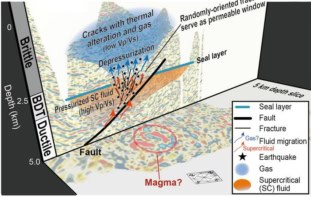An international team of researchers claims that a plan by the US military to shield hundreds of low Earth-orbit satellites from aerial nuclear explosions and powerful solar storms could also disrupt global communications and navigation systems for up to a week. They say that the proposed "radiation belt remediation" system would temporarily change the upper atmosphere from a mirror bouncing high frequency radio waves around the Earth to a sponge that absorbs them instead.
The calculations were carried out by a team led by space physicist Craig Rodger from the University of Otago in New Zealand. The work also suggest that the system would have a short-lived impact on the ozone layer, similar to that caused by solar storms or volcanic eruptions (Annales Geophysicae 24 2025-2041).
There are currently about 250 satellites in low-Earth orbit at altitudes of 160–480 km. These devices provide a diverse range of essential services such as long-distance radio communications, international broadcasting and GPS navigation services. However, satellites are vulnerable to failure caused by high-altitude nuclear airbursts or intense solar storms. Even a “small” nuclear detonation equivalent to 10 kilotons of TNT at heights of 125-300 km could cause 90% of satellites to fail within a month and delay manned spaceflights for a year or more.
A nuclear detonation releases vast numbers of electrons that would “pump up” the Van Allen belts, which are two bands of charged particles trapped high in the atmosphere by the Earth’s magnetic field. As these intense streams of belt electrons hit the satellites, they produce penetrating X-rays causing significant damage to onboard electronics and corrupting data sensors.
To mitigate this effect, the US Air Force and the US Defense Advanced Research Projects Agency have proposed a remediation system that uses radio waves at very low frequencies of about 20 kHz to flush the excess energetic particles from the belts and dump them into the upper atmosphere, well away from the satellites.
Rodgers and colleagues from the British Antarctic Survey, the Finnish Meteorological Institute and the Sodankylä Geophysical Observatory in Finland have performed calculations that suggest this process would significantly alter the upper atmosphere, albeit only temporarily. In particular, it would modify the ionosphere, which is vital for radio communications because it reflects signals making long-distance radio transmissions possible. The modified ionosphere would absorb radio waves, effectively shutting down communications – a disruption that worsens the longer the system is operated.
Unlike severe solar flares, where the effect is limited to the sunlit sector of the Earth, the disturbances from the remediation system could affect both the sunlit and night sectors worldwide and isolate some locations for up to a week. Airplane pilots and ships could lose contact and GPS systems are also unlikely to be immune as the deluge of particles will distort signals between satellites and receivers, the researchers say.
Although Rodger thinks the remediation system may be warranted in the extreme case of high-altitude nuclear explosions, he says it may be unsuitable for mitigating intense natural events such as solar flares and that policymakers should carefully consider its implications.



